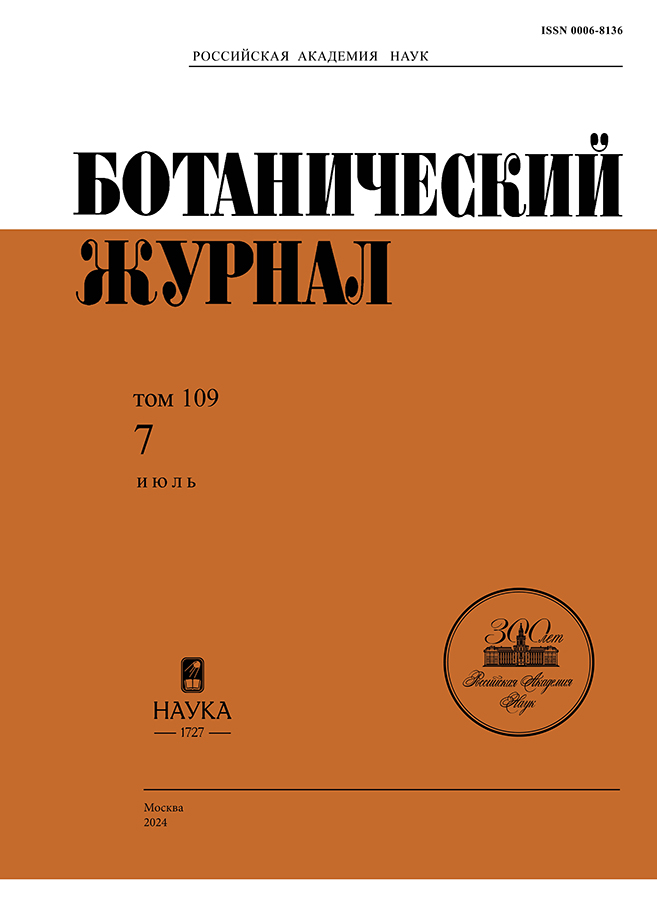Development of female and male reproductive structures in Borodinia macrophylla (Brassicaceae)
- Авторлар: Vinogradova G.Y.1, Chimitov D.G.2, Brukhin V.B.1
-
Мекемелер:
- Komarov Botanical Institute RAS
- Institute of General and Experimental Biology SB RAS
- Шығарылым: Том 109, № 7 (2024)
- Беттер: 688-696
- Бөлім: COMMUNICATIONS
- URL: https://archivog.com/0006-8136/article/view/666526
- DOI: https://doi.org/10.31857/S0006813624070047
- EDN: https://elibrary.ru/PSNZMZ
- ID: 666526
Дәйексөз келтіру
Аннотация
For the first time, cytoembryological study of the female and male reproductive structures development in the East Siberian endemic, Borodinia macrophylla (Turcz.) O.E. Schulz (order Capparales, family Brassicaceae, tribe Boechereae), is presented. The general plan of the reproductive structures development occurs similarly to the studied species of Boechera. The anther contains 4 microsporangia with four layers, namely epidermis, endothecium, middle layer, and tapetum at the beginning of development; as the anther matures, the wall becomes two-layered. The anther tapetum is unevenly 2-layered, microsporocytes develop simultaneously; most pollen grains in mature anthers are bicellular. The ovule is ortho-campylotropous, bitegmic, medionucellate. The embryo sac is 7-celled, 8-nucleate, formed according to the monosporic Polygonum type. The polar nuclei of the central cell in the mature embryo sac do not fuse. Female gametophytes developed in all the ovules studied. In B. macrophylla, only a sexual mode of reproduction was observed; no apomictic development was detected.
Негізгі сөздер
Толық мәтін
Авторлар туралы
G. Vinogradova
Komarov Botanical Institute RAS
Хат алмасуға жауапты Автор.
Email: vinogradova-galina@binran.ru
Ресей, Prof. Popova Str., 2, St. Petersburg, 197022
D. Chimitov
Institute of General and Experimental Biology SB RAS
Email: dabac@mail.ru
Ресей, Sakhyanovoy Str., 6, Ulan-Ude, 670047
V. Brukhin
Komarov Botanical Institute RAS
Email: vbrukhin@gmail.com
Ресей, Prof. Popova Str., 2, St. Petersburg, 197022
Әдебиет тізімі
- Alexander P.J., Windham M.D., Beck J.B., Al-Shehbaz I.A., Allphin L., Bailey C.D. 2013. Molecular phylogenetics and taxonomy of the genus Boechera and related genera (Brassicaceae: Boechereae). – Syst. Bot. 38(1): 192–209. https://doi.org/10.1600/036364413X661917
- Al-Shehbaz I.A. 2003. Transfer of most North American species of Arabis to Boechera (Brassicaceae). – Novon. 13(4): 381–391. https://doi.org/10.2307/3393366.
- Al-Shehbaz I.A. 2005. Nomenclatural notes on Eurasian Arabis (Brassicaceae). – Novon. 15(4): 519–524.
- Al-Shehbaz I.A., German D.A. 2010. Proposal to conserve the name Boechera against Borodinia (Cruciferae). – Taxon. 59: 648–649. https://doi.org/10.1002/tax.592037
- Al-Shehbaz I.A., Windham M.D. 2010. Boechera. Flora of North America: north of Mexico. 7: Magnoliophyta. Salicaceae to Brassicaceae. Oxford, UK.
- Anenkhonov O.A., Chimitov D.G. 2023. Large-leaved Borodinia (Borodinia macrophylla (Turcz.) O.E. Schulz). – Red Book of the Republic of Buryatia: Plants and Mushrooms. 4th ed., add. and processed. Belgorod. P. 219 (In Russ.).
- Brukhin V., Osadtchiy J.V., Florez-Rueda A.M., Smetanin D., Bakin E., Nobre M.S., Grossniklaus U. 2019. The Boechera genus as a resource for apomixis research. – Front. Plant Sci. 10: article 392 (P. 1–19). https://doi.org/10.3389/fpls.2019.00392
- Carman J.G., Mateo de Arias M., Gao L., Zhao X., Kowallis B., Sherwood D.A., et al. 2019. Apospory in addition to diplospory is common in Boechera where it may facilitate speciation by recombination-driven apomixis-to-sex reversals. – Front. Plant Sci. 10: article 724 (P. 1–14). https://doi.org/10.3389/fpls.2019.00724
- Chimitov D.G., Imetkhenova O.V. 2019. Findings of rare and endemic plant species in the Republic of Buryatia. – Bot. Zhurn. 104(2): 118–121 (In Russ.). https://doi.org/10.1134/S0006813619020030
- Hay N.M., Windham M.D., Mandáková T., Lysak M.A., Hendriks K.P., Mummenhoff K., Lens F., Pryer K.M., Bailey C.D. 2023. A Hyb-Seq phylogeny of Boechera and related genera using a combination of Angiosperms353 and Brassicaceae-specific bait sets. –Am. J. Bot. 110(10): e16226. https://doi.org/10.1002/ajb2.16226
- Iljina G.M. 1962. Embriologicheskoe issledovanie gorchitsy Brassica juncea (L.) Czern. (Embryological study of mustard, Brassica juncea (L.) Czern. – Vestnik Moscow State University. 1: 34–45 (In Russ.).
- Kiefer C., Dobeš C., Koch M. A. 2009. Boechera or not? Phylogeny and phylogeography of eastern North American Boechera species (Brassicaceae). – Taxon. 58: 1109–1121. https://doi.org/10.1002/tax.584005
- Kuzmina T.N. 2007. Development of the anther and male gametophyte of Cardamine graeca L. (family Brassicaceae). – Bulletin of the Nikitsky Botanical Garden. 95: 66–69 (In Russ.).
- Kuzmina T.N., Shevchenko S.V. 2008. Formation of male and female generative spheres in Brassica taurica (Tzvel.) Tzvel. (family Brassicaceae). – Proceedings of the Nikitsky Botanical Garden. 129: 71–86 (In Russ.).
- Li F.-W., Rushworth C.A., Beck J.B., Windham M.D. 2017. Boechera microsatellite website: an online portal for species identification and determination of hybrid parentage. – Database 2017: baw169. https://doi.org/10.1093/database/baw169
- Mandáková T., Hloušková P., Windham M.D., Mitchell-Olds T., Ashby K., Price B., Carman J., Lysak M. 2020. Chromosomal evolution and apomixis in the cruciferous tribe Boechereae. – Front. Plant Sci. 11: article 514 (P. 1–17). https://doi.org/10.3389/fpls.2020.00514
- Mandáková T., Ashby K., Price B.J., Windham M.D., Carman J.G., Lysak M.A. 2021. Genome structure and apomixis in Phoenicaulis (Brassicaceae; Boechereae). – J. Syst. Evol. 59(1): 83–92. https://doi.org/10.1111/jse.12555
- Rodionova G.B. 1966а. Megasporogenez u Hesperis steveniana DC. (Megasporogenesis in Hesperis steveniana DC.). – Vestnik Moscow State University. 5: 68–72 (In Russ.).
- Rodionova G.B. 1966b. Embriologicheskoe issledovanie Eruca sativa Lam. (Embryological study of Eruca sativa Lam.). – Vestnik Moscow State University. 1: 61–68 (In Russ.).
- Rodionova G.B. 1979. Razvitie zhenskikh embrionalnykh struktur, endosperma i zarodysha u sverbigi vostochnoi (Development of female embryological structures, endosperm and embryo in Bunias orientalis). – Bull. Glavnogo Bot. Sada. 113: 90–96 (In Russ.).
- Pausheva Z.P. 1980. Praktikum po tsitologii rastenii (Manuals for plant cytology]. Moscow. 255 p. (In Russ.).
- Shamrov I.I. 2002. Ovule and seed morphogenesis in Capsella bursa-pastoris (Brassicaceae) in connection with peculiar mode of endothelium formation. – Bot. Zhurn. 87(2): 1–18 (In Russ.).
- Shamrov I.I. 2007. The ovule and seed morphogenesis in Arabidopsis thaliana (Brassicaceae). – Bot. Zhurn. 92(7): 945–964 (In Russ.).
- Shamrov I.I. 2008. Ovule of flowering plants: structure, functions, origin. Moscow. 350 p. (In Russ.).
- Shamrov I.I. 2017. Morphological types of ovules in flowering plants. – Bot. Zhurn. 102(2): 129–146 (In Russ.).
- Vinogradova G.Yu., Sinelnikova N.V., Taskin K.M., Brukhin V.B. 2023. Development of female reproductive structures in Boechera species (Brassicaceae) during sexual and apomictic modes of reproduction. – Bot. Zhurn. 108(12): 1100–1118 (In Russ.).
Қосымша файлдар












